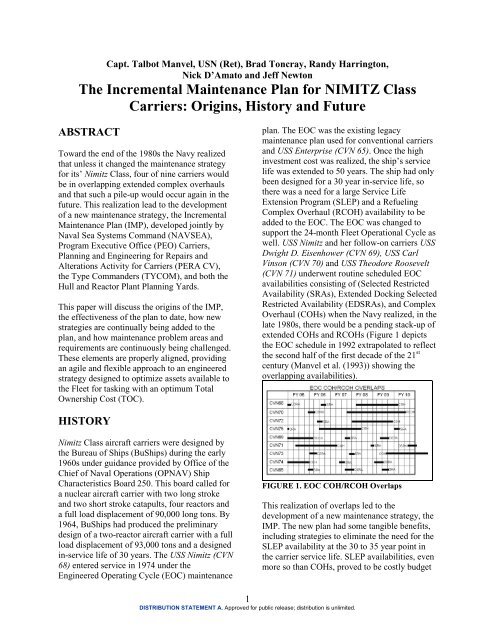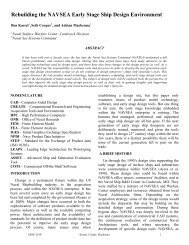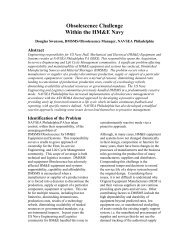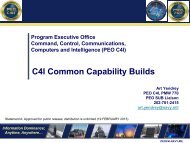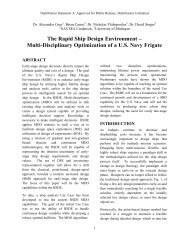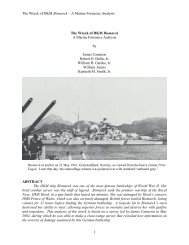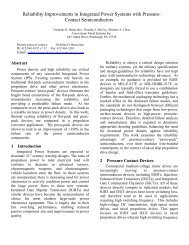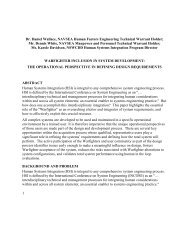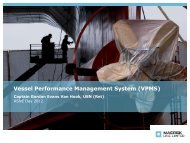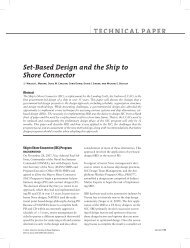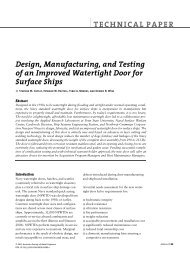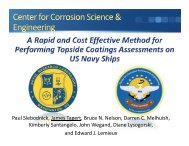FMS2010 IMP Paper - ASNE
FMS2010 IMP Paper - ASNE
FMS2010 IMP Paper - ASNE
You also want an ePaper? Increase the reach of your titles
YUMPU automatically turns print PDFs into web optimized ePapers that Google loves.
Capt. Talbot Manvel, USN (Ret), Brad Toncray, Randy Harrington,<br />
Nick D’Amato and Jeff Newton<br />
The Incremental Maintenance Plan for NIMITZ Class<br />
Carriers: Origins, History and Future<br />
ABSTRACT<br />
Toward the end of the 1980s the Navy realized<br />
that unless it changed the maintenance strategy<br />
for its’ Nimitz Class, four of nine carriers would<br />
be in overlapping extended complex overhauls<br />
and that such a pile-up would occur again in the<br />
future. This realization lead to the development<br />
of a new maintenance strategy, the Incremental<br />
Maintenance Plan (<strong>IMP</strong>), developed jointly by<br />
Naval Sea Systems Command (NAVSEA),<br />
Program Executive Office (PEO) Carriers,<br />
Planning and Engineering for Repairs and<br />
Alterations Activity for Carriers (PERA CV),<br />
the Type Commanders (TYCOM), and both the<br />
Hull and Reactor Plant Planning Yards.<br />
This paper will discuss the origins of the <strong>IMP</strong>,<br />
the effectiveness of the plan to date, how new<br />
strategies are continually being added to the<br />
plan, and how maintenance problem areas and<br />
requirements are continuously being challenged.<br />
These elements are properly aligned, providing<br />
an agile and flexible approach to an engineered<br />
strategy designed to optimize assets available to<br />
the Fleet for tasking with an optimum Total<br />
Ownership Cost (TOC).<br />
plan. The EOC was the existing legacy<br />
maintenance plan used for conventional carriers<br />
and USS Enterprise (CVN 65). Once the high<br />
investment cost was realized, the ship’s service<br />
life was extended to 50 years. The ship had only<br />
been designed for a 30 year in-service life, so<br />
there was a need for a large Service Life<br />
Extension Program (SLEP) and a Refueling<br />
Complex Overhaul (RCOH) availability to be<br />
added to the EOC. The EOC was changed to<br />
support the 24-month Fleet Operational Cycle as<br />
well. USS Nimitz and her follow-on carriers USS<br />
Dwight D. Eisenhower (CVN 69), USS Carl<br />
Vinson (CVN 70) and USS Theodore Roosevelt<br />
(CVN 71) underwent routine scheduled EOC<br />
availabilities consisting of (Selected Restricted<br />
Availability (SRAs), Extended Docking Selected<br />
Restricted Availability (EDSRAs), and Complex<br />
Overhaul (COHs) when the Navy realized, in the<br />
late 1980s, there would be a pending stack-up of<br />
extended COHs and RCOHs (Figure 1 depicts<br />
the EOC schedule in 1992 extrapolated to reflect<br />
the second half of the first decade of the 21 st<br />
century (Manvel et al. (1993)) showing the<br />
overlapping availabilities).<br />
HISTORY<br />
Nimitz Class aircraft carriers were designed by<br />
the Bureau of Ships (BuShips) during the early<br />
1960s under guidance provided by Office of the<br />
Chief of Naval Operations (OPNAV) Ship<br />
Characteristics Board 250. This board called for<br />
a nuclear aircraft carrier with two long stroke<br />
and two short stroke catapults, four reactors and<br />
a full load displacement of 90,000 long tons. By<br />
1964, BuShips had produced the preliminary<br />
design of a two-reactor aircraft carrier with a full<br />
load displacement of 93,000 tons and a designed<br />
in-service life of 30 years. The USS Nimitz (CVN<br />
68) entered service in 1974 under the<br />
Engineered Operating Cycle (EOC) maintenance<br />
FIGURE 1. EOC COH/RCOH Overlaps<br />
This realization of overlaps led to the<br />
development of a new maintenance strategy, the<br />
<strong>IMP</strong>. The new plan had some tangible benefits,<br />
including strategies to eliminate the need for the<br />
SLEP availability at the 30 to 35 year point in<br />
the carrier service life. SLEP availabilities, even<br />
more so than COHs, proved to be costly budget<br />
1<br />
DISTRIBUTION STATEMENT A. Approved for public release; distribution is unlimited.
targets and reduced carrier operational<br />
availability and were found to miss the mark on<br />
completely re-baselining material readiness due<br />
to underfunding maintenance requirements.<br />
COHs themselves were also problematic in that<br />
availability durations routinely extended far<br />
beyond proscribed Chief of Naval Operations<br />
(CNO) completion dates, with delays averaging<br />
101 days between 1983 and 1995. Figure 2<br />
shows the improved <strong>IMP</strong> FY05 to FY10<br />
maintenance schedule.<br />
<br />
<br />
<br />
<br />
<br />
Focus on published technical requirements<br />
Learn from depot level repair experiences<br />
Incorporate data from similar equipment and<br />
maintenance strategies used elsewhere in the<br />
fleet<br />
Enact best practices and LEAN initiatives<br />
where appropriate and,<br />
Create ship alterations to address barriers<br />
when required.<br />
Under the EOC plan the strategy was to allow<br />
the ships material condition to gradually<br />
degrade, then return the material condition to a<br />
higher state of readiness during COHs. In<br />
practice, the resulting readiness state never<br />
reached the previous benchmark (Figure 3).<br />
FIGURE 2. <strong>IMP</strong> Actual PIA/DPIA/RCOH<br />
Overlaps<br />
PHILOSOPHY, STRATEGY,<br />
PLAN DEVELOPMENT AND<br />
RESULTS<br />
The philosophy of the <strong>IMP</strong> is simple:<br />
Create a plan that maintains carriers in a<br />
more consistent state of material readiness<br />
throughout its service life by executing a<br />
series of more consistently sized<br />
availabilities. This reduces the budget and<br />
shipyard workload spikes and mitigates the<br />
loss of sailor readiness suffered under the<br />
EOC’s long duration (12 to over 18 month)<br />
COHs.<br />
Do away with the need for historically time<br />
consuming and unsuccessful SLEP<br />
availabilities at the 30 to 35 year service life<br />
point by better managing carrier<br />
infrastructure and distributive system<br />
deterioration.<br />
FIGURE 3. EOC Strategy<br />
One of the strategies transitioning from EOC to<br />
<strong>IMP</strong> was to reduce or eliminate the ―gap‖<br />
created from the COH inefficiencies. The plan<br />
took mandatory and condition based<br />
maintenance man days and applied them<br />
throughout the ship’s life in a robust continuous<br />
maintenance process rather than allowing a build<br />
up to be addressed during COHs (Figure 4). In<br />
Figure 4, the EOC strategy of allowing the<br />
ship’s material condition to gradually degrade is<br />
shown as the bottom saw tooth curve, while the<br />
<strong>IMP</strong> strategy for 24-month and 32-month, with<br />
reduced long term readiness ―gap‖, are depicted<br />
as the red and blue lines, respectively.<br />
Following the <strong>IMP</strong> philosophy, the strategy is<br />
also simple:<br />
Build on historical knowledge<br />
Utilize maintenance history successes and<br />
failures<br />
2<br />
DISTRIBUTION STATEMENT A. Approved for public release; distribution is unlimited.
Level of Maintenance Condition<br />
SRA<br />
PIA<br />
PIA<br />
DSRA<br />
PIA<br />
PIA<br />
DPIA<br />
SRA<br />
DPIA<br />
PIA<br />
COH<br />
PIA<br />
PIA<br />
SRA<br />
DPIA<br />
DSRA<br />
PIA<br />
PIA<br />
SRA<br />
DPIA<br />
PIA<br />
COH<br />
DPIA<br />
SRA<br />
PIA<br />
PIA<br />
DSRA<br />
PIA<br />
PIA<br />
SRA<br />
RCOH<br />
RCOH<br />
RCOH<br />
EOC<br />
<strong>IMP</strong>-24<br />
<strong>IMP</strong>-32<br />
2 4 6 8 10 12 14 16 18 20 22<br />
Years<br />
<strong>IMP</strong> 32<br />
<strong>IMP</strong> 24<br />
FIGURE 4. EOC, <strong>IMP</strong>-24 and <strong>IMP</strong>-32 Readiness<br />
Strategy<br />
EOC vs. <strong>IMP</strong>-24<br />
Philosophy and strategy is one thing, but with<br />
concept execution, the plan development process<br />
and details were not always as simple. In order<br />
to affect a transition to the <strong>IMP</strong>, several steps<br />
were required to satisfy technical requirements<br />
in-place at the time. An initial study was<br />
conducted identify all the requirements and<br />
applicable certification durations and their<br />
impact on the new <strong>IMP</strong> cycle; the most<br />
significant being the existing 5 year docking<br />
requirement. Those identified strategies were<br />
then challenged or changed to ―push‖ or ―pull‖<br />
maintenance actions to fit within the new<br />
schedule. High cost evolutions (like dry<br />
docking) required a number of engineering<br />
changes (ship alterations) to gain technical<br />
justification to ―push‖ the requirement to 6<br />
years. Condition based assessments were<br />
implemented to assure appropriate monitoring,<br />
data collection and analysis were available to<br />
drive maintenance actions.<br />
In support of the development of the <strong>IMP</strong>, a<br />
phased maintenance strategy review was<br />
conducted. The strategy incorporated the<br />
following steps:<br />
Define a complete list of maintenance<br />
requirements with the number of affected<br />
components, equipment and systems, along<br />
with their required level of repair.<br />
Sequence maintenance actions by<br />
availabilities.<br />
EOC<br />
<br />
<br />
Account for the age of the ship within its life<br />
cycle: Modify the levels of repair based on<br />
age degradation calculations and apply an<br />
―aging factor‖ across scheduled<br />
availabilities.<br />
Employ a time-based approach to budgeting<br />
while conforming to a condition based<br />
approach to maintenance.<br />
The review evaluated requirements, workload,<br />
manning, critical paths, testing and services.<br />
The work was comprehensively ―sequenced‖<br />
and all the maintenance requirements level<br />
loaded across the ships service life. This<br />
―Sequencing Plan‖ approach became an integral<br />
building block of the shift from the EOC to <strong>IMP</strong>.<br />
The <strong>IMP</strong> was composed of repeating 24-month<br />
operating cycles with one major 6-month<br />
Planned Incremental Availability (PIA)<br />
maintenance period per cycle. Every repeating<br />
third cycle, the major maintenance availability<br />
was a 10.5-month Docking Planned Incremental<br />
Availability (DPIA).<br />
To accommodate the ―aging factor‖, budgetary<br />
baselines were established, and shipyard<br />
workload requirements were identified. Then<br />
the notional availabilities were divided into a<br />
three-tier set of notional maintenance periods<br />
categories based on anticipated man days due to<br />
the life of the ship and the expected<br />
requirements (Figure 5). Initial man day<br />
requirements were set in 1992 and have been<br />
modified as the <strong>IMP</strong> evolved.<br />
Figure 5: Notional Aircraft Carrier Life Cycle &<br />
Aging Factors<br />
Once the categories were developed, the<br />
shipyards that work on aircraft carriers reviewed<br />
them in order to determine if they were<br />
achievable in relation to capacity. Norfolk Naval<br />
3<br />
DISTRIBUTION STATEMENT A. Approved for public release; distribution is unlimited.
Shipyard (NNSY) and Puget Sound Naval<br />
Shipyard (PSNS) determined they could execute<br />
the first two categories of availabilities (called<br />
PIA1s, PIA2s, DPIA1s and DPIA2s), but that<br />
the third set (PIA3s and DPIA3s) exceeded<br />
capacity by 2,000 men per day. During the<br />
initial EOC timeframe (circa 1992) the shipyard<br />
had excess capacity (NNSY: 11,205 personnel<br />
and PSNS and IMF: 12,356 personnel). When<br />
the <strong>IMP</strong> was developed and the availability<br />
categories were defined, the Shipyards had<br />
reduced their manning significantly. By fiscal<br />
year (FY) 2004, NNSY had 7,778 personnel and<br />
PSNS and IMF was manned at 9,421 personnel.<br />
Mitigation strategies (such as contracting of<br />
additional work) were developed to compensate<br />
for the lack of manpower capacity to support the<br />
PIA3 and DPIA3’s. One strategy was to reduce<br />
the workload within the availability by having a<br />
spare available for a wholesale change out of the<br />
equipment, instead of using vital manpower to<br />
overhaul in place. The equipment would then be<br />
repaired during a time when the shipyard was at<br />
less demand. The program was called the Carrier<br />
Planned Equipment Replacement (CARPER)<br />
program.<br />
Today, man day requirements are continuously<br />
reviewed as part of the overall feedback process.<br />
Table 1 shows the original PIA/DPIA depot man<br />
day requirements and subsequent changes.<br />
TABLE 1: Original Depot Man day<br />
Requirements and Changes<br />
At the same period of time that the <strong>IMP</strong> was<br />
being developed, the carrier maintenance<br />
community established a process improvement<br />
organization called Carrier Team One (CT1), a<br />
knowledge sharing network developed to<br />
improve the execution of availabilities. Though<br />
not created directly as a result of the inception of<br />
<strong>IMP</strong>, CT1 has matured in parallel with the <strong>IMP</strong><br />
and has played no small role in its success.<br />
Advantages of <strong>IMP</strong>-24<br />
The shift from the EOC strategy to <strong>IMP</strong>-24 was<br />
a major change in the way carrier maintenance<br />
had been conducted for many years, and yielded<br />
significant gains. The 24-month operating cycle<br />
(<strong>IMP</strong>-24) provided for more consistently sized<br />
availabilities and, as a result, produced:<br />
More consistent short term and long term<br />
readiness.<br />
Increased ship availability and surge<br />
capability.<br />
Leveled the profile of the maintenance and<br />
related budget spikes by incrementally<br />
executing the work throughout the carrier’s<br />
service life.<br />
Provided ships with the right capabilities as<br />
a result of focusing on condition based<br />
maintenance and modernization.<br />
Unnecessary maintenance under the<br />
antiquated time based maintenance plan left<br />
too much variability for effective planning.<br />
Level loaded the maintenance industrial<br />
base by comprehensively listing and<br />
sequencing all the maintenance requirements<br />
by shop and trade skill.<br />
<br />
More accurate and predictable schedules and<br />
maintenance workload forecasts.<br />
COMNAVSEASYSCOM letter of June 91<br />
applied an ―Aging Factor‖ to account for the<br />
effects of aging on ship system repairs.<br />
<br />
Reduced the number of docking<br />
availabilities (EDSRA vs. DPIA) by four,<br />
resulting in:<br />
o<br />
o<br />
o<br />
Increased carrier service life operational<br />
availability (A O ) by 18 months.<br />
Reduced the number of maintenance<br />
man days by 985,000 man days per<br />
carrier over its 50 year service life<br />
(Note: The majority of these man day<br />
reductions were associated with services<br />
(project management, dry dock support)<br />
rather then ―wrench turning‖ work.<br />
Ensured all ―wrench turning‖ work<br />
reductions were the result of<br />
4<br />
DISTRIBUTION STATEMENT A. Approved for public release; distribution is unlimited.
modernization design changes or<br />
Technical Warrant Holder (TWH)<br />
approved study recommendations.<br />
New strategies were developed for components<br />
with periodic inspections (flex hoses,<br />
pressurized cylinders, tanks, voids, and wire<br />
ropes, among others). Availability durations,<br />
critical paths, trade skill demands and spare part<br />
requirements were all evaluated to optimize<br />
successful maintenance period execution. The<br />
total effect resulted in a ―Sequencing Plan‖ that<br />
reapportioned maintenance man days and<br />
workloads across the entire carrier life cycle and<br />
industrial infrastructure. The Sequencing Plan<br />
included the deletion of inefficient SLEP<br />
availabilities. Although not always tied directly<br />
to the <strong>IMP</strong> effort, the carrier maintenance<br />
community leadership had introduced specific<br />
system upgrades (ship alterations) to extend the<br />
service life of systems determined to be in<br />
jeopardy beyond 30 years (e.g., changing 90/10<br />
firemain piping to 70/30 copper nickel).<br />
Additionally, original design infrastructure and<br />
distributive system service margins (electrical<br />
power, fiber optic cable plant status, chill water<br />
capacity, firemain, etc.) were closely monitored<br />
using a program called the Ships System Status<br />
Program (SSSP).<br />
The <strong>IMP</strong> was officially approved as the CVN<br />
68’s Class Maintenance Plan in 1994 and the<br />
first PIA was executed in FY97. As <strong>IMP</strong><br />
availabilities were completed, the entire <strong>IMP</strong><br />
approach was validated. A Carrier unique<br />
Project Management College (PMC) was<br />
instituted under the leadership of the newly<br />
established CT1. Post availability ―Hot<br />
Washes‖ were reviewed, and the planning and<br />
execution successes and failures and<br />
―knowledge sharing‖ elements of CT1 all<br />
contributed to the overall positive validation<br />
process.<br />
EVOLUTION OF THE <strong>IMP</strong><br />
When the <strong>IMP</strong> was first established,<br />
―maintenance‖ was scheduled based upon a<br />
consistent and predictable 24-month operational<br />
cycle of ―heel-to-toe‖ deployments. In 2001,<br />
operational demands associated with the events<br />
following September 11, 2001 resulted in an<br />
increase in the average length between <strong>IMP</strong><br />
availabilities from 24-months to 27-months as<br />
allowed by OPNAVNOTE 4700 tolerances.<br />
<strong>IMP</strong>-24 vs. <strong>IMP</strong>-27 vs. <strong>IMP</strong>-32<br />
In 2004, the operational cycle for a CVN 68<br />
Class Aircraft Carrier was officially modified<br />
and recognized in the OPNAVNOTE 4700 of<br />
June 2004 as 27 months. Adoption of a<br />
27-month cycle resulted in a reduction of the<br />
total number of depot availability opportunities<br />
executed and the elimination of approximately<br />
400,000 man days of life cycle maintenance.<br />
The most significant factor related to the 2004<br />
transition to a 27-month operational cycle was<br />
the determination to not adjust or modify<br />
programmed notional man days to account for<br />
the two (2) deleted PIAs, one during each half of<br />
the ship’s life (12 months of depot time).<br />
Because of the heavily condition based <strong>IMP</strong>, as<br />
well as the usage of better materials and<br />
preservation systems, it was assessed there<br />
would be negligible impact on material<br />
readiness in extending the operational cycle by<br />
three months.<br />
Concurrently in 2004, in an effort to provide<br />
even more operational availability to fleet<br />
commanders, Commander, NAVSEA requested<br />
PMS 312, under PEO Carriers, evaluate the<br />
technical feasibility of increasing the length<br />
between availabilities from 27-months to<br />
32-months. This technical review by all<br />
maintenance stakeholders, coincident with<br />
technical approval to extend the dry-docking<br />
interval for the Nimitz Class to 8 years,<br />
concluded that there were no technical<br />
impediments to extending the time between<br />
depot availabilities to 32-months. The dry-dock<br />
interval extension–from 6 years to 8 years—<br />
required a full technical review which validated<br />
the extension, represented an acceptable and<br />
manageable level of risk, and was approved by<br />
the Technical Warrant Holders (TWH) as<br />
outlined in PEO Carriers letter of March 2005.<br />
The major 32 month/8 year docking Study<br />
concluded in 2006 with the approval of the 32-<br />
5<br />
DISTRIBUTION STATEMENT A. Approved for public release; distribution is unlimited.
DPIA3<br />
DPIA3<br />
DPIA3<br />
PIA3<br />
CIA 3<br />
PIA3<br />
CIA 3<br />
CIA 3<br />
PIA3<br />
CIA 3<br />
PIA3<br />
CIA 3<br />
CIA 2<br />
PIA2<br />
CIA 2<br />
PIA2<br />
CIA 2<br />
CIA 3<br />
PIA3<br />
CIA 3<br />
PIA3<br />
CIA 3<br />
CIA 2<br />
PIA2<br />
PIA2<br />
DPIA2<br />
CIA 1<br />
PIA1<br />
PIA1<br />
CIA 2<br />
CIA 2<br />
CIA 1<br />
CIA 1<br />
month operating cycle (<strong>IMP</strong>-32). This last<br />
iteration has had the following additional<br />
benefits to the Navy and the Fleet:<br />
An additional reduction in the number of<br />
CNO availabilities by four; two PIAs and<br />
two DPIAs (totaling 33 months of depot<br />
time over the lifecycle of each aircraft<br />
carrier).<br />
An increase in a carrier’s service life A O by<br />
an additional 11 months from <strong>IMP</strong>-24 to<br />
<strong>IMP</strong>-32.<br />
Although providing more A O , the loss of these<br />
availabilities resulted in the removal of 1.12M<br />
man days of original depot level work.<br />
Approximately half of these man days are<br />
associated with items such as test programs and<br />
docking costs (services) that are completely<br />
eliminated and result in actual cost avoidances.<br />
The remaining half is actual maintenance<br />
requirements that must be accounted for and<br />
reprogrammed into the updated class<br />
maintenance plan. A Continuous Maintenance<br />
(CM) strategy was developed using Carrier<br />
Incremental Availabilities (CIAs) to incorporate<br />
a portion of the missed requirements. Another<br />
change was the increase in size of some DPIAs<br />
by one category (e.g., DPIA1 to DPIA2). The<br />
latest <strong>IMP</strong> strategy increases platform<br />
availability to the operator in support of a Fleet<br />
Response Plan (FRP) 6 available aircraft carriers<br />
plus 1 in docking (6+1) philosophy and includes<br />
the CM Strategy.<br />
In order to account for the displaced 433,000<br />
―wrench turning‖ maintenance man days<br />
removed by the reduction of maintenance<br />
availabilities, every maintenance opportunity has<br />
been utilized, including a reprogramming of the<br />
―wrench turning‖ man days into the remaining<br />
DPIAs and newly established CIAs, depicted in<br />
Figure 6.<br />
53.1k MDs<br />
Over DPIA1<br />
20.6 k<br />
MDs Btwn<br />
Each Avail<br />
32-Month Operational Cycle Continuous<br />
Maintenance<br />
24.2 k MDs<br />
Btwn Each<br />
Avail<br />
47.7k MDs<br />
Over DPIA2<br />
27.8 k MDs<br />
Btwn Each<br />
Avail<br />
24.2 k MDs<br />
Btwn Each<br />
Avail<br />
148.5k Mandays Redistributed<br />
47.7k MDs<br />
Over DPIA2<br />
27.8k MDs<br />
Btwn Each<br />
Avail<br />
FIGURE 6. 32-Month Operational Cycle with<br />
Continuous Maintenance<br />
The evolution of the <strong>IMP</strong> from its inception has<br />
resulted in a total 937,300 maintenance man<br />
days reduction per ship over its 50 year service<br />
life by removing services associated with 6<br />
fewer availabilities.<br />
RESULTS—ADVANTAGES OF<br />
<strong>IMP</strong> OVER EOC<br />
Since implementing <strong>IMP</strong>-24 the aircraft carrier<br />
maintenance community has continued to<br />
challenge maintenance requirements as part of<br />
ongoing total ownership cost improvement<br />
initiatives. This evolution has resulted in<br />
improved benefits that include:<br />
Fleet Benefits<br />
o Increased platform readiness (Ao)<br />
o Material ready assets<br />
o Assets with the right capabilities at the<br />
right time<br />
o Improved confidence in Budget<br />
Requirements and Schedules<br />
TYCOM Benefits<br />
o Reduced maintenance costs<br />
o Improved maintenance forecasting<br />
capability<br />
o Levelized funding - easily defendable.<br />
Maintenance Providers Benefits<br />
o Improved maintenance forecasting<br />
o Levelized shipyard loading; including at<br />
the shop and trade skill levels<br />
Ships Force Benefits<br />
o Better able to maintain qualification<br />
proficiency<br />
o More predictable schedules<br />
6<br />
DISTRIBUTION STATEMENT A. Approved for public release; distribution is unlimited.
K-Man-days<br />
Deviation from OPNAV Completion (Days)<br />
Deviation From OPNAV Completion (Days)<br />
The evolution of the <strong>IMP</strong> provides critical<br />
short-term (current) readiness to support<br />
post-9/11 FRP surge requirements, while<br />
accommodating long-term (future) readiness by<br />
minimizing infrastructure and distributive<br />
system deterioration ―gaps‖ to ensure full<br />
service life at a significantly reduced cost.<br />
400<br />
350<br />
300<br />
250<br />
200<br />
150<br />
100<br />
50<br />
CVN68 CL Depot Availability Duration History - EOC<br />
Figure 7 illustrates the ―step down‖ in total<br />
maintenance man day costs resulting from the<br />
sequential move from EOC to the <strong>IMP</strong>-32. The<br />
seven per cent (7%) increase in man days from<br />
the 1994 <strong>IMP</strong>-24 to the 2002 <strong>IMP</strong>-24 is a result<br />
of quality of life (QOL) initiatives which shifted<br />
work traditionally accomplished by ships force<br />
(such as fire watches) to maintenance providers.<br />
0<br />
(50)<br />
(100)<br />
1982 1984 1986 1988 1990 1992 1994 1996 1998<br />
FIGURE 8. EOC Availability Duration History –<br />
EOC<br />
400<br />
350<br />
300<br />
250<br />
CVN68 CL Depot Availability Duration History - <strong>IMP</strong><br />
7000<br />
200<br />
150<br />
6000<br />
100<br />
5000<br />
- 22 %<br />
+ 7 %<br />
- 6 %<br />
- 14 %<br />
50<br />
0<br />
4000<br />
(50)<br />
(100)<br />
1994 1996 1998 2000 2002 2004 2006 2008 2010<br />
3000<br />
2000<br />
FIGURE 9. Depot Availability Duration History -<br />
<strong>IMP</strong><br />
1000<br />
0<br />
1992 EOC 1994 <strong>IMP</strong>-24 2002 <strong>IMP</strong>-24 2004 <strong>IMP</strong>-27 2006 <strong>IMP</strong>-32<br />
FIGURE 7. Comparison of Carrier Life Cycle<br />
Man day Totals<br />
Based on Programs of Record, there has been a<br />
reduction of approximately 2 million man days<br />
per carrier over its 50 year service life<br />
(excluding Shipbuilding and Conversion, Navy<br />
(SCN) funded RCOH), equating to roughly $1B<br />
cost avoidance per carrier.<br />
The <strong>IMP</strong> strategy to develop precisely planned<br />
availabilities, tailored to accommodate shipyard<br />
shop and trade skill capabilities, combined with<br />
CT1 project management initiatives have<br />
resulted in significantly improved availability<br />
execution. Figure 8 depicts the deviation from<br />
OPNAV established maintenance duration the<br />
carrier community experienced under the EOC.<br />
Figure 9 is a similar scatter gram reflecting<br />
availabilities after implementation of the <strong>IMP</strong><br />
and shows a significant improvement of<br />
schedule adherence.<br />
A comparison of the notional data indicates that<br />
depot time under the EOC was 33% of a carrier<br />
life cycle versus only 20% under the <strong>IMP</strong>-32. It<br />
should be noted that the data excludes RCOH<br />
and Post-RCOH Post Shakedown Availability<br />
(PSA)/SRA timelines.<br />
<strong>IMP</strong> FUNCTIONALITY<br />
The <strong>IMP</strong> gains its functionality from the<br />
foundation by which it was built. Clearly<br />
identified and articulated technical requirements<br />
are the cornerstones while hard lessons learned<br />
from historical challenges provide the structural<br />
strength. Inputs to the <strong>IMP</strong> are (1) Core<br />
technical requirements and (2) Historical<br />
feedback requirements (Figure 10 (Note: The<br />
information flow is BI-DIRECTIONAL for all<br />
these functions except for historical feedback<br />
(which by definition is unidirectional)).<br />
Requirements, Budgets, Workload Forecasting<br />
and Baseline Availability Work Package<br />
(BAWP) development are iteratively updated as<br />
feedback information validates (or invalidates)<br />
7<br />
DISTRIBUTION STATEMENT A. Approved for public release; distribution is unlimited.
and refines the information contained in the<br />
<strong>IMP</strong>.<br />
FIGURE 10. Functions of the <strong>IMP</strong><br />
Requirements: The <strong>IMP</strong> serves as the single<br />
authoritative repository of all ―off ship‖<br />
technical maintenance requirements defined by<br />
higher order documents such as Naval Ship<br />
Technical Manuals (NSTM’s), General<br />
Specifications for Overhaul (GSO), Steam and<br />
Electric Plant Manual, etc. The key<br />
organizations (not all inclusive), which set the<br />
requirements are: OPNAV, SEA 05, SEA 08,<br />
Naval Air Systems Command (NAVAIR),<br />
Naval Surface Warfare Center (NSWC),<br />
Commander Naval Air Forces (CNAF), etc. ―On<br />
ship‖ technical maintenance requirements are<br />
managed through the Preventative Maintenance<br />
Schedule (PMS).<br />
Feedback: The <strong>IMP</strong> serves as the repository of<br />
historical execution feedback from the Naval<br />
Supervising Authority (NSA), In-Service<br />
Engineering Agents (ISEAs), etc. required to<br />
continuously validate and improve the plan<br />
itself.<br />
The key Output functions of the <strong>IMP</strong> are:<br />
To develop notional budgets for OPNAV<br />
and the Program Objective Memorandum<br />
(POM) process.<br />
To develop the Material Unit Cost (MUC)<br />
rates for COMNAVAIRFOR. This MUC is<br />
used to convert expected Material demands<br />
to a man day rate in order to budget under<br />
the same units.<br />
To develop workload forecasts for SEA 04<br />
in order to project the industrial base<br />
workload for future years.<br />
To develop BAWPs for the Naval Aviation<br />
Enterprise (NAE).<br />
To serve as the single authoritative data<br />
repository for ―off ship‖ maintenance<br />
requirements and financial information to<br />
enable ―war gaming/what if‖ data calls. An<br />
example of this was the ability to generate a<br />
2,600 page ―cradle to grave‖ forecast of<br />
Baseline Availability Work Package<br />
(BAWP) technical requirements for a<br />
―generic‖ aircraft carrier over its entire 50<br />
year in-service life. This package was used<br />
by OPNAV during POM12 to show that the<br />
notional allowances being requested were<br />
based on known and required work.<br />
Through ongoing review and continuous update<br />
of the <strong>IMP</strong>, the Carrier Planning Activity (CPA)<br />
(PMS 312C) accomplishes:<br />
Workload and financial notional reviews.<br />
Validation or improvements to the<br />
assessment plans.<br />
Availability work package growth analysis.<br />
<strong>IMP</strong> Flexibility – Double Deployments<br />
Under the <strong>IMP</strong>-24 there was only one<br />
deployment between maintenance periods. Table<br />
2, shows the <strong>IMP</strong>-32 flexibility to increased<br />
deployments when required, e.g., to date five (5)<br />
carriers have ―double deployed‖ between their<br />
maintenance periods. Review of maintenance<br />
data shows no significant increase in the Job<br />
Control Numbers (JCNs) the ―double deployed‖<br />
ships reported versus JCNs reported by the end<br />
of their single deployment operational cycles.<br />
8<br />
DISTRIBUTION STATEMENT A. Approved for public release; distribution is unlimited.
SRA<br />
SRA<br />
SRA<br />
SRA<br />
SRA<br />
SRA<br />
SRA<br />
SRA<br />
Carrier Action Date Start Date End<br />
CVN 68 PIA2 03/01/2006 08/30/2006<br />
Deploy 04/02/2007 09/30/2007<br />
Deploy 01/24/2008 06/03/2008<br />
PIA2 06/16/2008 12/16/2008<br />
CVN 69 PIA2 01/22/2008 07/23/2008<br />
Deploy 02/21/2009 07/30/2009<br />
Deploy 01/04/2010 Est. 07/2010<br />
PIA2 09/01/2010 02/28/2011<br />
CVN 70 PIA3 04/01/2002 08/30/2002<br />
Deploy 02/07/2003 09/18/2003<br />
Deploy 01/13/2005 07/13/2005<br />
RCOH 11/10/2005 07/11/2009<br />
CVN 72 DPIA2 06/23/2003 06/07/2004<br />
Deploy 10/15/2004 03/05/2005<br />
Deploy 02/27/2006 08/08/2006<br />
PIA3 09/05/2006 06/30/2007<br />
CVN 76 PIA1 05/01/2007 10/30/2007<br />
Deploy 05/19/2008 11/25/2008<br />
Deploy 05/28/2009 10/21/2009<br />
PIA1 11/09/2009 05/09/2010<br />
TABLE 2. ―Double Deploying‖ Carriers<br />
<strong>IMP</strong> Flexibility – Forward Deployed<br />
Naval Force (FDNF) Aircraft Carrier<br />
In 2008 a Nimitz Class aircraft carrier, USS<br />
George Washington (CVN 73), replaced USS<br />
Kitty Hawk (CV 63) as the Forward Deployed<br />
Naval Forces (FDNF) carrier in Yokosuka,<br />
Japan. This is the first time a nuclear powered<br />
vessel has been systematically maintained<br />
outside of the United States in a tethered<br />
forward deployed status.<br />
CVN 73 was under the CVN 68 Class <strong>IMP</strong>, and<br />
transitioned as the FDNF carrier to a modified<br />
<strong>IMP</strong> strategy utilizing annual 120-day SRAs in<br />
lieu of the 32/8 strategy detailed above. The 32/8<br />
CVN 68 Class <strong>IMP</strong> maintenance approach was<br />
considered for the forward deployed<br />
environment. Due to the unique forward<br />
deployed operational requirements of the FDNF,<br />
the 32/8 strategy did not support six consecutive<br />
months with the assigned carrier in a<br />
maintenance status. Two other availability<br />
scheduling options previously applied to the<br />
conventionally-powered aircraft carriers in<br />
Yokosuka were given primary consideration.<br />
Those two options were:<br />
Two annual 70-day availabilities and<br />
notional 15-day upkeep.<br />
Single annual 120-day availability and<br />
notional 30-day upkeep.<br />
The strategy involving the annual 120-day SRA<br />
(Figure 11) was selected primarily due to the<br />
following advantages:<br />
Consistent with FDNF Operational<br />
requirements.<br />
One availability start-up period and one test<br />
program per year vice two.<br />
Increased capability to accomplish more<br />
significant repairs/modernization during the<br />
longer maintenance period.<br />
Reduced overlap between planning of a<br />
follow-on availability and the execution of<br />
an ongoing availability.<br />
More efficient scheduling and execution of<br />
required work during the longer<br />
availabilities.<br />
2007<br />
FDNF Maintenance Schedule<br />
2008 2009 2010 2011 2012 2013 2014 2015 2016 2017 2018 2019<br />
DPIA PIA PIA RCOH<br />
<strong>IMP</strong> Maintenance Schedule<br />
FIGURE 11. Comparison of FDNF and <strong>IMP</strong><br />
Maintenance Schedules<br />
Building on both technical requirements and<br />
historical lessons learned, the scheduling of<br />
discrete ―work packages‖, and appropriately<br />
fitting the FDNF maintenance profile was both<br />
efficient and effective. The flexibility and<br />
functionality of the <strong>IMP</strong> was again proven.<br />
Managing the Plan (<strong>IMP</strong>)<br />
As can be seen by its evolution to date, the plan<br />
(<strong>IMP</strong>) has never been static, and has resulted in<br />
improved benefits as it moved from <strong>IMP</strong>-24 to<br />
<strong>IMP</strong>-27 to the current <strong>IMP</strong>-32 and <strong>IMP</strong>-FDNF.<br />
The carrier maintenance community is<br />
constantly challenging the plan and its<br />
underpinning requirements, and incorporating<br />
new strategies and tools to handle emerging<br />
issues and maintenance problem areas.<br />
Through teaming with Submarine Maintenance<br />
Engineering Planning and Procurement Activity<br />
(SUBMEPP) and the Surface Ship Life Cycle<br />
Management (SSCLM) Activity, and by<br />
identifying and using best practices and tools of<br />
other maintenance communities, NAE has been<br />
able to accelerate their efforts to increase the<br />
RCOH<br />
9<br />
DISTRIBUTION STATEMENT A. Approved for public release; distribution is unlimited.
efficiency of the <strong>IMP</strong>. Their involvement in<br />
organizations that make a difference to the base<br />
requirements, such as the Common Maintenance<br />
Plan Working Group (CMPWG) and<br />
Cumbersome Work Practice Group (CWP) are<br />
all important parts of managing the plan. The<br />
following are the major strategies and tools that<br />
orchestrate the Aircraft Carrier Class<br />
Maintenance Plan (ACCMP):<br />
ACCMP Manual: The ACCMP manual (PEO<br />
Aircraft Carriers 2006 and annual updates since)<br />
is the Program of Record that provides the<br />
overarching maintenance strategy and processes<br />
used to execute and manage life cycle<br />
maintenance for all aircraft carriers. The<br />
composition of life cycle maintenance is<br />
constantly evolving as strategies are affected by<br />
modernization, Reliability Centered<br />
Maintenance (RCM) analysis, maintenance<br />
process improvements and technical innovation.<br />
While the <strong>IMP</strong> provides the notional estimates<br />
for material costs, manpower costs in labor,<br />
engineering and overhead, the ACCMP<br />
integrates the technical requirements managed in<br />
the <strong>IMP</strong> into execution strategies to optimize<br />
when, where, and how the maintenance will be<br />
done. Current maintenance strategies include:<br />
Freeboard/Topside Maintenance, Tank<br />
Maintenance, and CVN 68 Class Non-Nuclear<br />
Cognizant Air Circuit Breaker Maintenance.<br />
Such a structured approach improves safety,<br />
maintenance effectiveness, reduces cost, and<br />
increases overall operational reliability through a<br />
carrier’s entire service life.<br />
Through the utilization of the CT1 Availability<br />
Work Package Development Process, the<br />
ACCMP maintenance strategies and<br />
requirements are meshed with modernization,<br />
deferred maintenance, ship’s force work items,<br />
and repair actions to define all significant “Life<br />
Cycle Work” required for a specific aircraft<br />
carrier’s 32-month operational cycle. The<br />
planning that results from executing the<br />
ACCMP supports carrier notional availability<br />
budget projections which are developed through<br />
the use of historical maintenance data, coupled<br />
with a continual review and challenging of<br />
requirements. This provides technical rigor to<br />
the process.<br />
Maintenance & Ship Work Planning<br />
(M&SWP) tool: In the past, the <strong>IMP</strong> was<br />
maintained in a CPA ―in-house‖ database.<br />
Through its efforts to identify best practices<br />
from the other maintenance communities they<br />
became aware of SUBMEPP’s M&SWP tool.<br />
This life cycle management planning tool was<br />
far more robust and versatile than CPA’s. As a<br />
result, CPA developed a Memorandum of<br />
Agreement (MOA) with SUBMEPP, and has<br />
modified M&SWP to accommodate CVN 68<br />
Class maintenance requirements. M&SWP<br />
provides a single database for management of<br />
Non-Nuclear ―off ship‖ Class Maintenance Plan<br />
(CMP) requirements, linked to configuration and<br />
historical completion data at the component<br />
level.<br />
The CPA has completed conversion from the old<br />
database and now the CVN 68 ACCMP ―off<br />
ship‖ requirements are housed in M&SWP.<br />
Since NAE’s adaptation of M&SWP, the Fleet<br />
has endorsed it under their Maintenance Figure<br />
of Merit (MFoM) initiative as the Program of<br />
Record and the SSLCM Activity has begun its<br />
transition to it as well.<br />
Corrosion Control Information Management<br />
System (CCIMS): CCIMS provides a single<br />
database containing the current detailed status of<br />
corrosion in aircraft carrier tanks, voids and<br />
plenums. CCIMS evolved from the Carrier Life<br />
Enhancing Repairs (CLER) program. The<br />
CCIMS database provides condition based<br />
scheduled inspection and work requirements and<br />
is a direct feed into M&SWP used for<br />
development of the BAWP. Since its inception<br />
in 2003, CCIMS has been the mechanism the<br />
Carrier community used to reduce the unknown<br />
tank coating conditions from 45% to 5%. Better<br />
management of the tank life cycle process has<br />
allowed the CPA to provide more accurate<br />
BAWP tank packages and budgets projections,<br />
which assists the executing activates in their<br />
ability to plan and execute. Additionally, the<br />
information derived from CCIMS resulted in<br />
successfully challenging and changing both<br />
inspection and preservation requirements<br />
resulting in a substantial cost avoidance.<br />
10<br />
DISTRIBUTION STATEMENT A. Approved for public release; distribution is unlimited.
CCIMS has been selected as the Program of<br />
Record for management of corrosion across the<br />
entire fleet and is utilized by all three Naval<br />
Enterprises.<br />
Requirements Review: There is a new and<br />
revitalized focus on challenging the core<br />
requirements with a TOC perspective.<br />
Baselining the CMPs: In response to a<br />
tasking from Commander, United States<br />
Fleet Forces Command, Class Maintenance<br />
Plan maintenance requirement Zero-Based-<br />
Reviews (ZBR) were conducted by a crossenterprise<br />
working group (eventually<br />
evolving into the CMPWG), chaired by<br />
NAVSEA 04RM and having members from<br />
ship maintenance planning organizations,<br />
ship life cycle managers, fleet<br />
representatives and technical managers. The<br />
ZBR validated that the maintenance plan<br />
requirements were derived from RCM based<br />
requirements, a higher-level technical<br />
requirement, or a regulatory directive. The<br />
outcome of the review resulted in 97% of<br />
the Aircraft Carrier requirements being<br />
validated; 1% deleted; and the remaining 2%<br />
have under gone reviews since to resolve.<br />
CMPWG: The CPA is a founding member<br />
of the CMPWG which is central to<br />
continuously challenging requirements and<br />
is in alignment with the Surface and<br />
Submarine Enterprises. The CMPWG was<br />
established in June 2006 consisting of<br />
NAVSEA 04RM, Naval Sea Logistics<br />
Center (NSLC), SUBMEPP and CPA. The<br />
Working Group operates as a cross platform<br />
cooperative group to achieve common<br />
maintenance requirements and associated<br />
best practices and to determine the right<br />
maintenance requirements across platforms.<br />
The ultimate purpose of the CMPWG is to<br />
optimize maintenance requirements and<br />
procedures across platforms and establish a<br />
culture of continuous improvement and<br />
knowledge sharing for developing<br />
maintenance requirements. This requires<br />
establishing the most applicable and<br />
effective requirements possible while<br />
institutionalizing periodic formal reviews of<br />
all maintenance requirements.<br />
<br />
NAE Knowledge Sharing Network: Over<br />
the last several years, the NAE has taken<br />
great effort in establishing a culture that<br />
aligns its various activities along the<br />
Personnel, Equipment, Supply, Training and<br />
Ordinance (PESTO) pillars. Under the ―E‖<br />
pillar various teams including the Life Cycle<br />
Management Group (LCMG), Cost<br />
Optimized Readiness E-Pillar (COR-E),<br />
Cost Wise Readiness Team (CWRT) and<br />
Ready for Tasking – Equipment (RFT-E)<br />
have been established. The LCMG focuses<br />
on current and future mission requirements<br />
in support of the aircraft carrier’s 50 year<br />
in-service life. Current platform, system and<br />
equipment concerns are identified and<br />
mitigation strategies explored to improve<br />
today’s readiness (Ao) and costs. Future<br />
requirements (Joint Strike Fighter<br />
integration, interoperability issues, etc.) are<br />
addressed through modernization and<br />
technology upgrades. To execute these<br />
responsibilities and support rigorous fact<br />
based and informed decisions, in 2006 the<br />
LCMG chartered the COR-E Cross<br />
Functional Team (CFT).<br />
The COR-E (Current Readiness, 2010)<br />
aligns resources across the carrier<br />
maintenance community through the<br />
identification, prioritization, analysis and<br />
mitigation of critical deckplate problems.<br />
The Team identifies equipment readiness<br />
and cost drivers, and provides a forum for<br />
knowledge management and transparency.<br />
The basic work of COR-E is divided into<br />
five (5) main Sub-Groups at the Working<br />
Group Level: Aircraft Launch and recovery<br />
(ALRE); Propulsion; Command, Control,<br />
Communication, Computer, and Combat<br />
System (C5I); Hull, Mechanical and<br />
Electrical (HM&E), and Logistics. Each of<br />
the Sub-Groups has its own Lead/Co-Lead<br />
and is in itself a CFT with membership from<br />
appropriate Systems Commands, Ships,<br />
TYCOM, Program Offices, etc. Members<br />
bring with them the inherent authority,<br />
responsibility and perspective of their parent<br />
organizations. COR-E’s taps into key<br />
maintenance community activities (not just<br />
organizations) to assure complete visibility<br />
11<br />
DISTRIBUTION STATEMENT A. Approved for public release; distribution is unlimited.
and transparency for all maintenance related<br />
issues.<br />
Equipment/system readiness trends are<br />
monitored by RFT-E Data, consisting of<br />
Impaired Days and Out of Commission<br />
(OOC) Days identified by ship’s force. The<br />
formal stand-up of COR-E has had a<br />
measureable impact. In FY09, the ―Top<br />
Five‖ Critical Shipboard Systems monitored<br />
by RFT-E data had their ―Impaired Days‖<br />
reduced by over 80 per cent. OOC<br />
equipment trend data shows a decline of<br />
approximately 45 per cent over a two and a<br />
half year span.<br />
The CWRT collects data for trending costs<br />
on both the findings of the CMPWG and the<br />
efforts of COR-E as they pertain to aircraft<br />
carriers and:<br />
Provides information to allow decisionmakers<br />
to provide the same readiness at<br />
reduced cost.<br />
Allows carrier community to better<br />
understand TOC.<br />
Promotes CWR decisions.<br />
Metrics assess benefits of CWR<br />
decisions and actions.<br />
Captures requirement changes that<br />
should be reflected during the ―9-Step‖<br />
development process.<br />
Captures and tracks all of the initiatives<br />
that affect the cost of aircraft carriers for<br />
the carrier maintenance community.<br />
Technical Foundation <strong>Paper</strong>s (TFPs): The<br />
CPA, along with SUBMEPP and SSLCM<br />
Activity for their respective enterprises,<br />
maintain a TFP for each ship class that<br />
documents how the technical requirements<br />
contained in the CMP are expressed as<br />
budgetary requirements. The TFP provides the<br />
background, rational and basis for the CNO<br />
availability notionals, both for labor, in man<br />
days, and material, in dollars, required to<br />
execute the ACCMP. These CNO availability<br />
notional allowances are documented in<br />
OPNAVNOTE 4700 which is issued annually to<br />
support the POM/PR budget process.<br />
Availability notional allowances are used as a<br />
tool to project long range budget requirements.<br />
The TFP also documents the business rules and<br />
processes used by NAE to refine the OPNAV<br />
Notional class allowances used for long range<br />
forecasting into a ship specific allowance for<br />
near term budget requirements. All three<br />
Enterprises use the Fleet managed ―9-Step‖<br />
Process to submit their budget requirements.<br />
These submissions are not only utilized in the<br />
budget process but also by the Public Shipyards<br />
in the development of their workload capacity<br />
plans.<br />
Bottom Line: These elements combined,<br />
including the ACCMP, <strong>IMP</strong>, maintenance<br />
strategies, requirements reviews, CMPWG,<br />
M&SWP, TFPs, and the proactive involvement<br />
of the Carrier maintenance community provide<br />
for an agile, flexible and properly aligned<br />
approach to an engineered strategy in support of<br />
affordable assets available to the Fleet for<br />
tasking. A recent audit of the CPA’s CMP<br />
Management Processes by the Board of<br />
Inspection and Survey (INSURV) to determine<br />
the effectiveness of the CMP maintenance<br />
processes for the USS Abraham Lincoln (CVN<br />
72) showed: 96% of the CMP requirements have<br />
Known Last Accomplished Dates, only 4.4% of<br />
the CMP Scheduled maintenance requirements<br />
were overdue; and that 100% of the past due<br />
requirements will be technically adjudicated by<br />
the official close out of the availability.<br />
Additionally, a recent internal requirements<br />
review of the 32-month operation/maintenance<br />
cycle, in-place since 2006, has shown no<br />
decrease in the ships material readiness since the<br />
latest iteration of the <strong>IMP</strong> was implemented.<br />
This was verified by a review of:<br />
Current Ship Maintenance Project (CSMP)<br />
trends.<br />
INSURV results.<br />
NAE, LCMG, COR-E Team efforts, and its<br />
RFT-E data trends.<br />
Comparison of level of readiness and<br />
material condition to previous (<strong>IMP</strong>-<br />
24/<strong>IMP</strong>-27) operational cycles.<br />
CPA’s Life Cycle Analysis.<br />
12<br />
DISTRIBUTION STATEMENT A. Approved for public release; distribution is unlimited.
Continued low level (
Maintenance, the <strong>IMP</strong> contributed to a legacy of<br />
on-time availability completions.<br />
Future challenges exist, both known (integration<br />
of CVN 78, JSF, etc.) and unknown (changing<br />
world environment), but the <strong>IMP</strong> strategy has<br />
proven highly adaptable and flexible to address<br />
whatever over the horizon events present.<br />
REFERENCES<br />
COMNAVSEASYSCOM ltr 4700/CV/CVN<br />
OPR PMS 312E/785 Ser 00/0656 of 4 Jun 91,<br />
Maintenance and Modernization Strategy for the<br />
CV/CVN and AVT Force<br />
Current Readiness & Enterprise AIRSpeed<br />
Newsletter; Volume 8, Issue 2, March 2010<br />
Manvel, T., M. Knight, K. A. Dieter, and L. R.<br />
Dutton, ―Incremental Maintenance for USS<br />
Nimitz (CVN68) Class Aircraft Carriers,‖<br />
Technical Proceedings, Fleet Maintenance<br />
Symposium, October 1993.<br />
OPNAVNOTE 4700 ser N431H/4U741235 of<br />
30 Jun 04, Representative Intervals, Durations,<br />
Maintenance Cycles, and Repair Mandays for<br />
Depot Level Maintenance Availabilities of U.S.<br />
Navy Ships<br />
PEO Carriers (PMS 312) ltr 4790 PMS312 Ser<br />
05-337 of 4 Mar 2005, Aircraft Carrier<br />
Drydocking Interval<br />
PEO Aircraft Carriers ltr 4700 PEO Ser 06-1203<br />
of 6 September 2006, Aircraft Carrier Class<br />
Maintenance Plan (ACCMP) (Rev 3 - Jan 2010)<br />
ACKNOWLEDGEMENTS<br />
Capt. Talbot Manvel, USN (Ret) is an Adjunct<br />
Master Instructor of Naval Architecture at the<br />
United States Naval Academy. A 1972 graduate<br />
of the US Naval Academy with a B.S. in Ocean<br />
Engineering, he retired from the U.S. Navy as an<br />
Engineering Duty Officer after 28 years of<br />
service. He served on three aircraft carriers,<br />
assisted in the supervision of the construction of<br />
two nuclear carriers, lead the development of<br />
the Incremental Maintenance Plan for the<br />
NIMITZ Class and the design development of<br />
the FORD Class.<br />
Bradley A. Toncray is the Chief Engineer and<br />
Engineering Division Manager for PEO<br />
Carriers PMS312C Carrier Planning Activity<br />
(CPA). Mr. Toncray holds a bachelors degree<br />
in Mechanical Engineering from the Georgia<br />
Institute of Technology. He began his career in<br />
1990 at Norfolk Naval Shipyard Engineering<br />
and Planning Department’s Propulsion<br />
Machinery Branch, working as a waterfront<br />
trouble-desk engineer, special-projects engineer,<br />
Project Engineering and Planning Manager<br />
(PEPM) and eventually as the acting branch<br />
head for the propulsion machinery branch. He<br />
transferred to the CPA Life Cycle Systems<br />
Engineering Branch as the Propulsion System<br />
Specialist and Aircraft Carrier Vibration<br />
Machinery Condition Analysis Program<br />
Manager in 1998. Mr. Toncray has represented<br />
the aircraft carrier community on several major<br />
life-cycle maintenance initiatives including the<br />
Common Class Maintenance Working Group<br />
(CMPWG), Material Assessment Cross<br />
Functional Team (MACFT) and the CVN 65<br />
Main Feed Pump Life Cycle Maintenance<br />
Engineering Task Force. Mr. Toncray was<br />
awarded the Department of the Navy<br />
Meritorious Civilian Service Award for his<br />
service to PEO Aircraft Carriers.<br />
Randal L. Harrington is the Life Cycle<br />
Engineering Division Manager for PEO<br />
Carriers PMS 312C Carrier Planning Activity.<br />
Mr. Harrington holds a bachelors degree in<br />
Mechanical Engineering from Michigan<br />
Technological University. He was recruited<br />
directly from college by Norfolk Naval Shipyard<br />
(NNSY) and began his career in the Engineering<br />
and Planning Department as a Planning Yard<br />
Design Engineer specializing in Heating,<br />
Ventilation and Air Conditioning (HVAC). Mr.<br />
Harrington’s career at NNSY included<br />
assignments as a design engineer; waterfront<br />
trouble desk engineer; branch head for several<br />
modernization and maintenance engineering<br />
codes; and concluded as the Project<br />
Engineering and Planning Manager (PEPM) for<br />
several ship availabilities. He has been with<br />
14<br />
DISTRIBUTION STATEMENT A. Approved for public release; distribution is unlimited.
CPA since 2000 serving as the Branch Head<br />
responsible for both the hull modernization plan<br />
and the class maintenance plan. Mr.<br />
Harrington is the co-author and a presenter of<br />
“Breaking the “Unique” Paradigm: Using<br />
Common Best Practices to Improve Navy<br />
Maintenance” presented at the 2007 <strong>ASNE</strong><br />
conference.<br />
maintenance, processes and Reliability Centered<br />
Maintenance (RCM) issues. Since retirement<br />
Mr. Newton has worked as a consultant for PRC<br />
Inc. and American Management Systems Inc.<br />
(AMS). He has been with AMSEC LLC, a<br />
subsidiary of Northrop Grumman Corporation,<br />
since 2002, and has supported the CPA since<br />
2004.<br />
Nicholas D’Amato is a Senior Strategic<br />
Planning Manager with AMSEC LLC<br />
supporting PMS 312 and PEO Carriers. He<br />
retired in 2008 as the Carrier Planning Activity<br />
Deputy after 38 years Government service. Mr.<br />
D’Amato holds a bachelors degree in<br />
Mechanical Engineering from Newark College<br />
of Engineering. His career began in 1969 at<br />
Norfolk Naval Shipyard in the Engineering<br />
Department’s Propulsion Machinery Branch.<br />
Career advancements included Propulsion<br />
Branch Head and 20 years as Assistant Chief<br />
Engineer. As a special assignment, Mr.<br />
D’Amato was technical lead for the CVN-68<br />
Class conversion from an Engineered Operating<br />
Cycle (EOC) to an Incremental Maintenance<br />
Plan (<strong>IMP</strong>). He was selected Deputy/Chief<br />
Engineer of the Carrier Planning Office at<br />
SUPSHIP Newport News in 1998. In 2006 the<br />
Carrier Planning Activity was realigned under<br />
the Aircraft Carrier Programs Office. With the<br />
introduction of Enterprise concept, Mr.<br />
D’Amato became a member of the NAE’s<br />
Carrier Readiness Team as (then) Co-Lead<br />
CAPT Tom Moore’s Action Officer. He joined<br />
AMSEC LLC, a subsidiary of Northrop<br />
Grumman Corporation, in January 2008 and<br />
continues to support the NAE, CRT and<br />
PMS-312.<br />
Jeffrey P. Newton is a Program Manager with<br />
AMSEC LLC. He graduated from Excelsior<br />
College with a bachelors degree in Liberal Arts<br />
and holds masters degrees in Public<br />
Administration and Human Resources<br />
Management from Troy University. He retired<br />
from the U.S. Navy as a LCDR (SWO) with over<br />
25 years of service in 1993. Mr. Newton was a<br />
participating member of the CVN 65 Main Feed<br />
Pump Life Cycle Maintenance Engineering Task<br />
Force and supports PMS 312C Carrier<br />
Planning Activity as a consultant for life cycle<br />
15<br />
DISTRIBUTION STATEMENT A. Approved for public release; distribution is unlimited.


